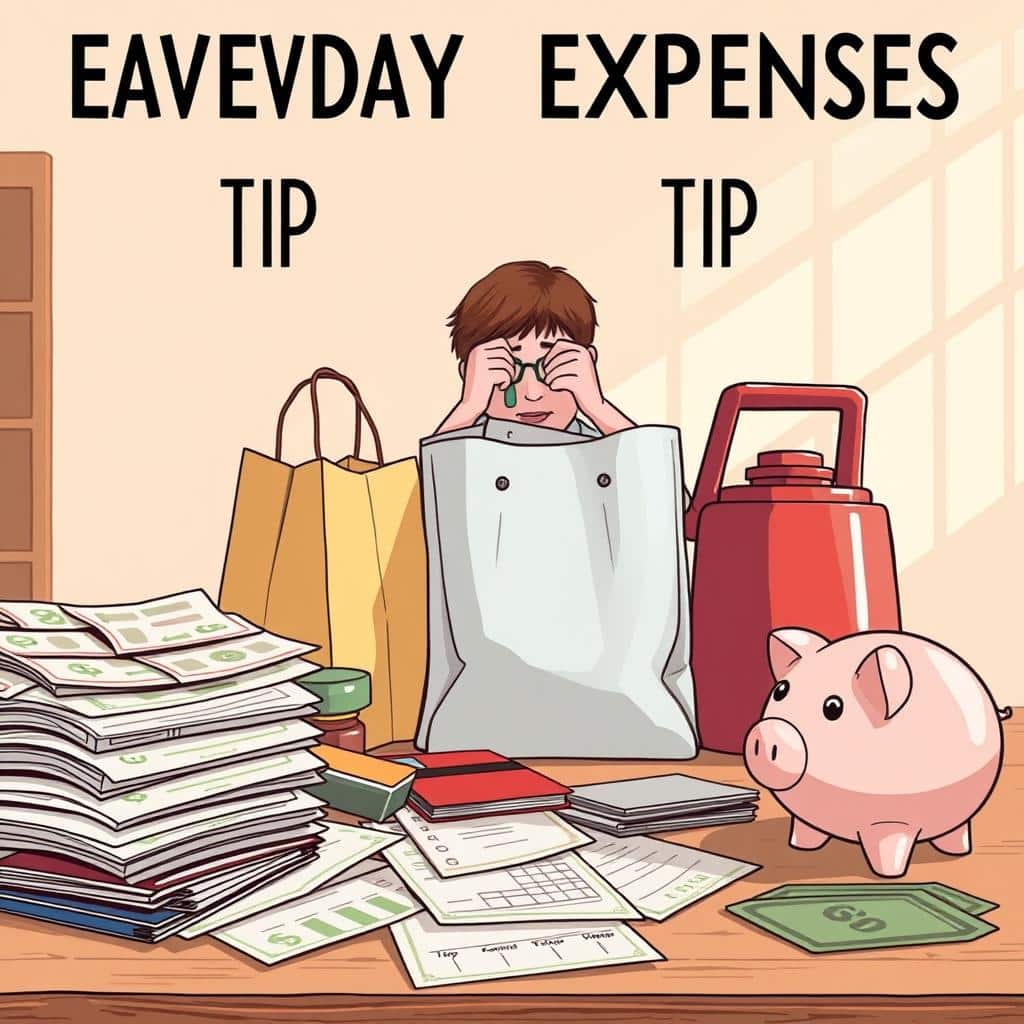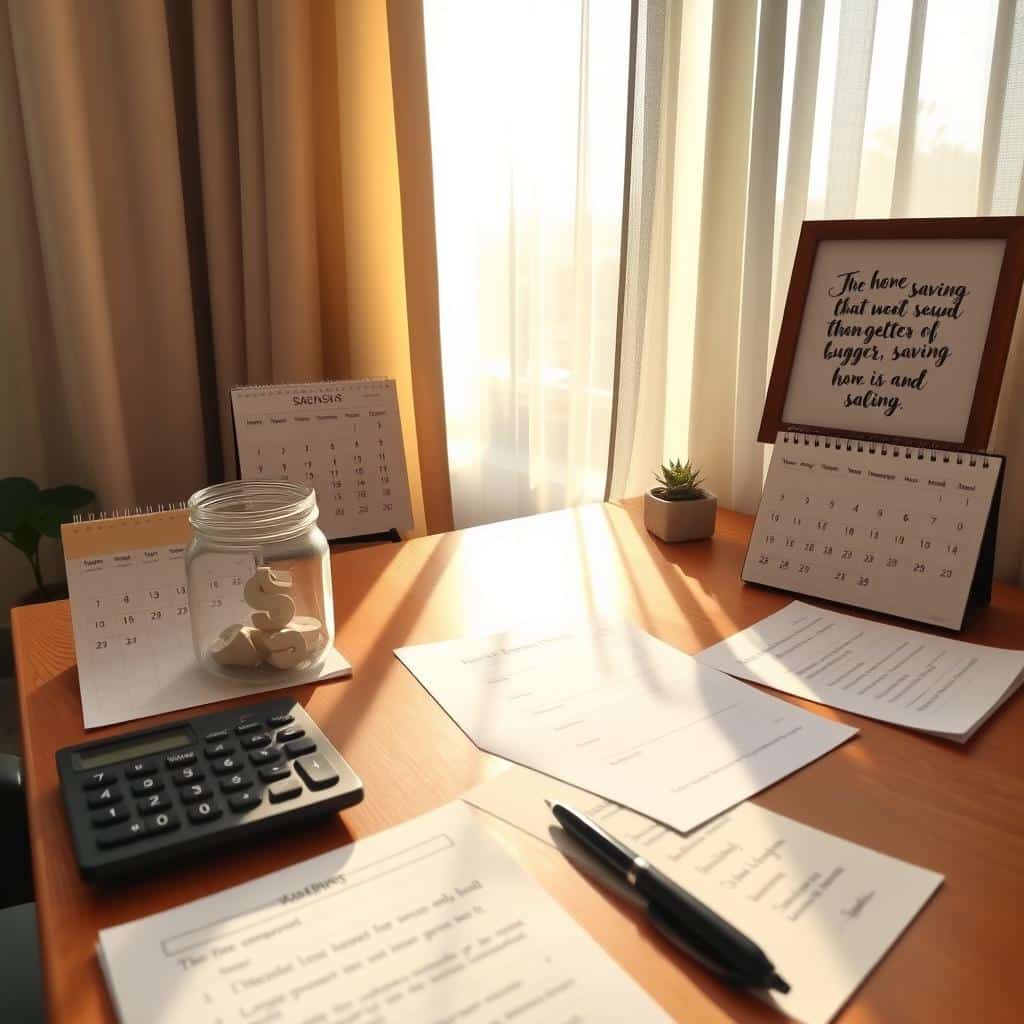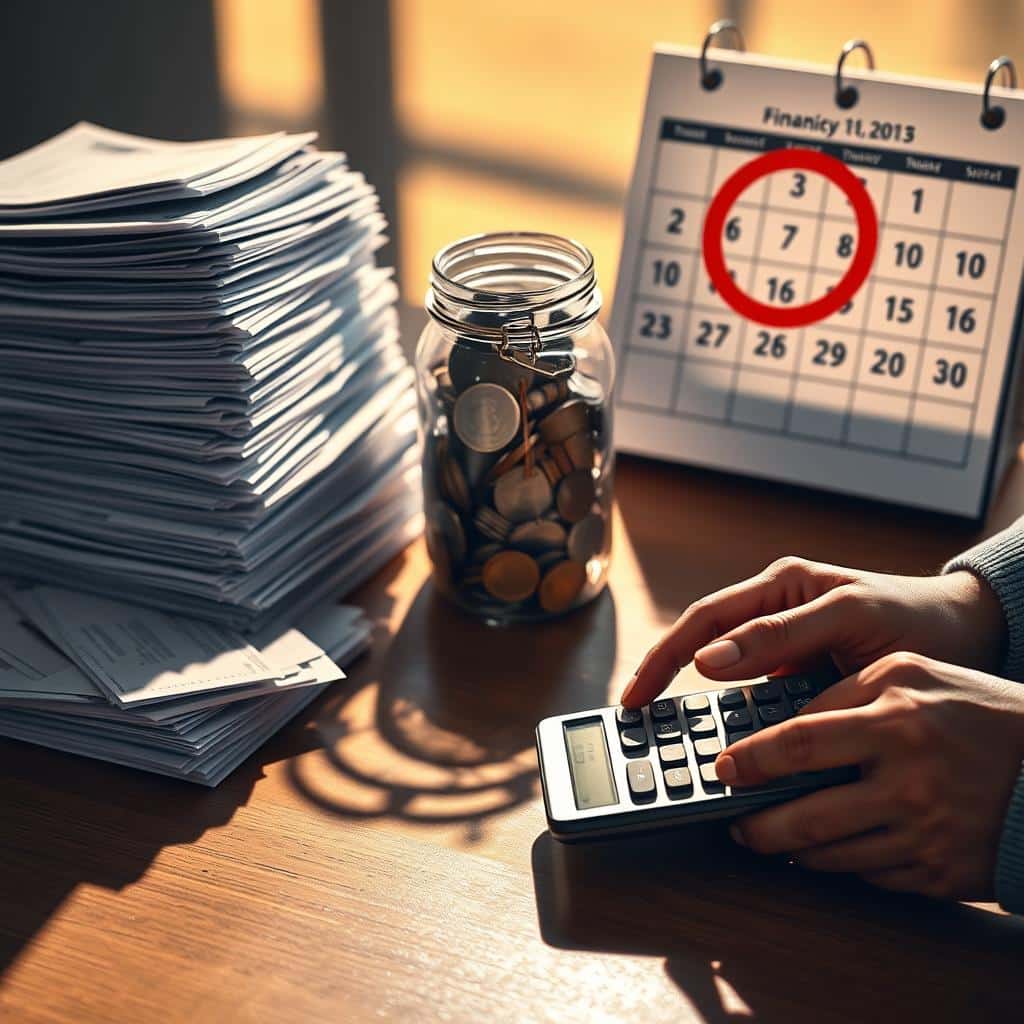Have you ever wondered how small changes in your daily habits can lead to big results over time? I used to think that managing finances required drastic measures, but I’ve learned that even minor adjustments in money saving tips can make a huge difference.
When I started focusing on my spending, I realized how much I could set aside without feeling deprived. It’s not about cutting out everything you enjoy—it’s about making smarter choices. Understanding your credit and how it impacts your overall financial health is also a game-changer.
In this article, I’ll share practical steps that have worked for me. From budgeting systems like the 50/30/20 rule to automating transfers, these strategies are easy to implement. Stick around, and you’ll discover how to save money without sacrificing the things you love.
Kickstarting Your Savings Journey Through Money Saving Tips
Starting your financial journey doesn’t have to be overwhelming—it’s all about taking that first step. For me, the most effective way to begin was by tracking my spending. This simple habit gave me a clear picture of where my resources were going and helped me identify areas where I could cut back.
One tip that made a big difference was using apps to monitor my expenses in real time. These tools allowed me to see patterns in my spending and adjust my habits accordingly. It’s amazing how much clarity you can gain by simply knowing where your budget is being allocated.
Another important step was analyzing how I spent my time and resources. I realized that some of my daily habits were leading to unnecessary expenses. By making small adjustments, like cooking at home more often, I was able to free up funds for more meaningful goals.
Setting aside a designated time each week for budgeting also became a game-changer. This routine provided structure and direction, making it easier to stay on track. Consistency is key, and even small actions can lead to significant progress over time.
For example, I started by saving just a few dollars each day. Over time, these small amounts added up, and I was able to build a solid financial cushion. It’s proof that even the simplest tips, when applied consistently, can make a big impact.
Find out more on 50 High-Paying Technology-Related Keywords for Google AdSense
Budgeting: The Heart of Saving Money Tips
Budgeting transformed how I manage my finances, and it can do the same for you. It’s not just about tracking numbers—it’s about creating a plan that works for your lifestyle. When I started budgeting, I realized how much control I could have over my expenses.
Understanding Your Expenses
The first step in budgeting is understanding where your resources go. I began by tracking every expense, from bills to grocery shopping. This helped me identify areas where I could cut back without feeling deprived.
One thing I learned is that small expenses add up quickly. For example, daily coffee runs or unplanned purchases can derail your plan. By keeping a close eye on these, I was able to redirect funds toward paying off debt and building savings.

Choosing the Right Budget System
There are many budgeting methods out there, but finding the right one is key. I tried the 50/30/20 rule, which allocates 50% of income to needs, 30% to wants, and 20% to savings and debt. This system worked well for me because it’s simple and flexible.
Another approach I explored was zero-based budgeting, where every dollar has a purpose. This method helped me stay disciplined, especially when it came to my grocery budget. By planning meals and sticking to a list, I avoided overspending at the store.
Ultimately, the best budget system is the one you can stick to. It’s about finding a plan that aligns with your goals and lifestyle.
money saving tips for Everyday Expenses
Everyday expenses might seem small, but they can add up faster than you think. I’ve found that focusing on daily spending can unlock surprising opportunities for growth. By making smart choices, I’ve been able to cut costs without feeling like I’m missing out.
One of my favorite strategies is meal planning. By preparing meals at home, I’ve saved hundreds of dollars each month. It’s not just about the item itself—it’s about avoiding unnecessary trips to the store and reducing waste. Plus, it’s healthier and more satisfying than eating out.

Another way I’ve cut costs is by eliminating impulse purchases. I now ask myself, “Do I really need this item?” before buying. This simple question has helped me avoid overspending on nonessentials. Over time, these small savings have added up significantly.
Balancing immediate spending with long-term goals like retirement is also crucial. I’ve started redirecting the money I save on daily expenses into my retirement fund. It’s a small step, but it’s making a big difference in securing my future.
“The little things matter. Small savings today can lead to big wins tomorrow.”
Consistency is key. I’ve made it a habit to review my spending weekly. This routine helps me stay on track and ensures I’m consistently saving money. It’s proof that even the simplest changes can have a lasting impact.
For example, I’ve switched to using energy-efficient appliances and turning off lights when not in use. These small actions have lowered my utility bills, freeing up more funds for my goals. It’s all about finding what works for you and sticking to it.
Setting Clear Money Savings Tips Goals
Setting clear goals is the foundation of any successful financial plan. Without a roadmap, it’s easy to lose track of your progress. I’ve found that defining what I want to achieve keeps me motivated and focused on the bigger picture.
Breaking down my aspirations into actionable steps has made them more attainable. Whether it’s building an emergency fund or planning for a major purchase, having specific targets helps me stay on track. Integrating these goals into my budgeting process has been a game-changer.

Short-Term Milestones
Short-term milestones are essential for maintaining momentum. I started by setting small, achievable targets, like saving $500 for an emergency fund. These quick wins kept me motivated and built confidence in my ability to reach larger goals.
I also review my monthly bill payments to ensure I’m not overspending. By adjusting these expenses, I free up more funds for my short-term objectives. It’s amazing how small changes can add up over time.
Long-Term Objectives
Long-term goals require patience and consistency. For me, this includes saving for retirement and paying off major debts. I break these objectives into smaller steps, like contributing a set amount each month to my retirement account.
Monitoring my spending habits has been crucial. I celebrate when I hit milestones, which keeps me motivated. It’s proof that even the smallest actions can lead to significant progress over time.
By aligning my budgeting with both short-term and long-term goals, I’ve been able to accelerate my financial growth. It’s a strategy that works for me, and it can work for you too.
Automate Your Money Savings Tips
Automating my finances was a game-changer for my routine. It’s a simple way to ensure I stay consistent without overthinking. By setting up automatic transfers, I’ve been able to grow my funds effortlessly.
I started by scheduling transfers right after each paycheck. This way, a portion of my income goes directly into savings before I even notice. It’s a practical approach that helps me avoid the temptation to spend that cash elsewhere.

Choosing a high-yield savings account made a big difference. These accounts offer better interest rates, allowing my cash to grow faster through compound interest. It’s a smart way to maximize my savings without extra effort.
Setting Up Automatic Transfers
The process is straightforward. I linked my checking account to a high-yield savings account and set up recurring transfers. I also adjusted the timing to align with my paydays. This ensures I’m consistently saving without fail.
One of the best parts is how it simplifies managing daily expenses. For example, I’ve been able to allocate more funds toward meal planning and other essentials. Automation removes the stress of manually tracking every dollar.
“Automating savings ensures consistency and removes the guesswork from financial planning.”
By automating, I’ve also freed up mental space. I no longer worry about forgetting to save or overspending. It’s a reliable way to stay on track with my goals, whether it’s building an emergency fund or planning for future needs.
If you’re looking for a hassle-free way to grow your funds, automation is worth considering. It’s a small change that can lead to significant results over time.
Cutting Down on Monthly Bills
Reducing monthly bills doesn’t have to feel like a chore—it’s about making smart adjustments. I’ve found that taking the time to review my expenses regularly can uncover hidden savings opportunities. Here’s how I’ve managed to lower my monthly costs without sacrificing convenience.

Negotiating Service Costs
One of the most effective strategies I’ve used is negotiating service costs. For example, I called my internet provider and asked for a better deal. After a quick conversation, I was able to reduce my monthly bill by a significant amount. It’s worth checking if your providers offer discounts or promotions.
I also compare service plans regularly. This helps me ensure I’m getting the best value for my amount. Many companies are willing to negotiate if you’re a loyal customer, so don’t hesitate to ask.
Eliminating Unnecessary Subscriptions
Another area where I’ve saved is by cutting out subscriptions I no longer use. I started by reviewing all my recurring charges and asking myself if I really needed each one. For example, I realized I was paying for a streaming service I rarely watched.
I made it a habit to check my accounts monthly. This ensures I’m only paying for services I truly use. It’s amazing how much you can save by eliminating just a few unnecessary subscriptions.
“Small adjustments to your monthly bills can lead to big savings over time.”
By taking these steps, I’ve been able to free up more funds for my goals. It’s a simple yet effective way to take control of your finances.
Smart Grocery Shopping Strategies
Grocery shopping doesn’t have to break the bank—smart strategies can make a big difference. I’ve found that a little planning and the right tools can help me stay within my budget while still enjoying fresh, healthy meals. Here’s how I’ve made grocery shopping more efficient and cost-effective.

Meal Planning Tactics
Meal planning has been a game-changer for me. By deciding what to cook in advance, I avoid last-minute, often expensive choices. I start by creating a weekly menu based on what’s already in my pantry. This idea not only reduces waste but also helps me stick to my shopping list.
I also use a grocery app to organize my list and track deals. These tools make it easy to compare prices and find discounts. Plus, they remind me of items I might forget, like spices or condiments. It’s a simple yet effective way to stay on track.
Maximizing Coupons and Loyalty Rewards
Coupons and loyalty programs have saved me a lot over time. I always check my grocery store’s app for digital coupons before heading out. These small discounts add up, especially when combined with store promotions.
I also use a rewards card for every purchase. Many stores offer points or cashback, which I redeem for future savings. It’s a great idea to sign up for these programs if you haven’t already. Over time, the rewards can make a significant difference.
“Using coupons and loyalty programs is like getting paid to shop smart.”
Another tip is to time your purchases during peak sale periods. For example, I stock up on non-perishables when they’re on sale. This strategy ensures I’m always getting the best value for my money.
By combining meal planning, apps, and loyalty rewards, I’ve been able to cut my grocery costs without sacrificing quality. It’s proof that small changes can lead to big savings.
Paying Off High-Interest Debt
Tackling high-interest debt was one of the most impactful decisions I made for my financial health. It’s not just about reducing what you owe—it’s about freeing up more funds for your savings account and long-term goals. High-interest debt can feel overwhelming, but with a clear plan, it’s manageable.
I started by prioritizing my debts. Instead of spreading my extra funds thin, I focused on paying off the highest interest balances first. This approach, often called the avalanche method, saved me a significant amount in interest over time. Every dollar I saved from not paying high-interest fees went straight into my savings account.

Visualizing my progress kept me motivated. I created a chart to track both my debt reduction and savings growth. Seeing those lines move in opposite directions was incredibly rewarding. It reinforced the habit of saving while I worked toward my savings goal.
One of the biggest benefits of paying off high-interest debt is the financial freedom it brings. Without those high monthly payments, I had more resources to allocate toward my savings and emergency fund. It’s amazing how much easier it is to build wealth when you’re not weighed down by debt.
“Paying off high-interest debt isn’t just about eliminating a burden—it’s about creating opportunities for growth.”
If you’re struggling with high-interest debt, start by making a plan. Focus on one balance at a time, and celebrate each milestone. Over time, you’ll see how reducing debt can accelerate your progress toward your savings goal. It’s a powerful step toward financial stability and peace of mind.
Embracing High-Yield Financial Tools As Money Saving Tips
Making the most of your financial tools can significantly boost your progress toward your goals. For me, shifting to high-yield savings accounts was a turning point. These accounts offer better returns compared to traditional ones, helping me grow my funds faster without extra effort.

When I first explored high-yield options, I was surprised by the differences. Traditional accounts often have lower interest rates, while high-yield accounts can offer rates up to 3.80% APY. This means more growth for my savings over time. I made sure to research each account’s terms, focusing on low fees and competitive rates.
Balancing my credit card usage was also part of the plan. By avoiding high-interest debt, I could redirect more funds into my high-yield account. This approach aligns with my broader financial goal of building long-term stability.
One of the best parts is how these tools fit into both short-term and long-term plans. Whether it’s saving for an emergency fund or planning for retirement, high-yield accounts have been a reliable way to stay on track. It’s proof that the right financial tools can make a big difference.
“High-yield accounts aren’t just about better returns—they’re about creating opportunities for growth.”
If you’re looking to accelerate your progress, consider exploring high-yield financial tools. They’ve been a key part of my strategy, and they can work for you too.
Practicing Mindful Spending and Delayed Gratification
Mindful spending has completely changed how I approach my finances, making every dollar count. It’s not about restricting myself—it’s about ensuring each purchase aligns with my monthly budget and long-term goals. By taking a moment to evaluate every expense, I’ve been able to prioritize what truly matters.
One of my favorite strategies is the 30-day rule. If I’m tempted by an impulse buy, I wait 30 days before making the purchase. This delay helps me determine if the item is a need or just a want. More often than not, I realize I don’t need it, and that’s money saved for my fund goals.

Tracking my spending has also been a game-changer. I review my income and expenses weekly to ensure I’m staying on track. This routine helps me identify areas where I can cut back and redirect funds toward my priorities. It’s amazing how small adjustments can add up over time.
Aligning my spending with my financial goals has made a noticeable difference. For example, I’ve started allocating a portion of my income to an emergency fund. This simple habit has given me peace of mind and a sense of control over my finances.
“Mindful spending isn’t about deprivation—it’s about making choices that align with your values and goals.”
Mindful spending is a continuous journey. It’s about being intentional with every dollar and recognizing the impact of small decisions. By practicing delayed gratification and staying consistent, I’ve been able to build a healthier financial future.
Utilizing Budgeting Apps and Financial Tools
Budgeting apps have become my go-to tool for staying on top of my finances. They’ve simplified how I track every expense, from daily coffee runs to monthly bills. With just a few taps, I can see where my resources are going and make adjustments as needed.
One of the best features is the ability to monitor detailed rate information. Whether it’s a loan or a credit card, these apps provide real-time updates on interest rates and due dates. This helps me stay informed and avoid unnecessary fees.

Setting alerts for upcoming payments has been a game-changer. I no longer worry about missing deadlines or incurring late fees. The apps send reminders directly to my phone, ensuring I stay on track with my financial obligations.
Digital tools have transformed how I handle my payment plans. Instead of juggling multiple platforms, everything is consolidated in one place. This streamlined approach saves time and reduces stress, making financial management feel effortless.
Using the right app has turned what used to be a tedious process into a daily routine. I can review my expenses, adjust my budget, and plan for future goals all in a matter of minutes. It’s proof that technology can make managing finances both simple and effective.
“Budgeting apps aren’t just tools—they’re partners in achieving financial clarity and control.”
If you’re looking for a way to simplify your finances, I highly recommend exploring budgeting apps. They’ve made a significant difference in my life, and they can do the same for you.
Leveraging Transportation Savings
Transportation costs can take a big bite out of your budget, but they don’t have to. I’ve found that by making small adjustments, I’ve been able to save significantly year after year. It’s all about being mindful of how you use your car and other transportation methods.

One of the first things I did was evaluate my car expenses. Regular maintenance, like oil changes and tire rotations, has helped me avoid costly repairs down the line. I also compare insurance rates every year to ensure I’m getting the best deal. These steps have made a noticeable difference in my long-term savings.
Optimizing Car Costs and Gas Usage
Fuel consumption is another area where I’ve focused. By planning my errands efficiently, I’ve reduced the number of trips I take each week. Carpooling with friends or coworkers has also helped cut down on gas expenses. These small changes add up over time and contribute to my long-term financial goals.
I’ve also paid attention to car financing terms. High interest rates can eat into your budget, so I made sure to shop around for the best loan options. This approach has allowed me to save more on my monthly payments and redirect those funds toward other priorities.
“Small adjustments in transportation habits can lead to significant savings over time.”
Another strategy I use is reviewing fuel rates regularly. I take advantage of apps that show the cheapest gas stations in my area. This simple habit has saved me a surprising amount of money over the year.
By combining these methods, I’ve been able to optimize my transportation costs without sacrificing convenience. It’s proof that even small changes can make a big impact on your long-term financial health.
Entertainment and Dining Out on a Budget
Finding ways to enjoy life without overspending has been a game-changer for me. I love social outings, but I’ve learned to prioritize budget-friendly alternatives that don’t compromise my long-term goals. By being mindful of my expenses, I’ve been able to enjoy dining and entertainment without breaking the bank.
One of my favorite strategies is researching local free or low-cost events. Instead of paying premium service fees for concerts or shows, I look for community gatherings, outdoor movies, or museum discount days. These options are just as fun and often come with a much lower price tag.

When it comes to dining out, I’ve found that sharing meals is a great way to save. Many restaurants serve large portions, so splitting an entrée not only reduces costs but also minimizes food waste. I also take advantage of happy hour specials and discount offers to keep my dining expenses in check.
Using reward programs has been another key part of my strategy. Many restaurants and entertainment venues offer loyalty programs that provide discounts or freebies. By signing up for these, I’ve been able to enjoy my favorite activities while staying within my budget.
“Enjoying life doesn’t have to mean overspending. With a little planning, you can have fun and stay financially responsible.”
I also plan my entertainment budget carefully. By setting aside a specific amount each month, I ensure that every outing aligns with my financial goals. This approach helps me avoid unnecessary interest rate impacts from overspending on my credit card.
Another tip is to explore transportation options that save on car expenses. For example, carpooling or using public transit to get to events can reduce fuel and parking costs. These small adjustments add up and allow me to allocate more funds toward my priorities.
By combining these strategies, I’ve been able to enjoy dining and entertainment without compromising my financial health. It’s proof that with a little creativity, you can have fun and stay on track with your goals.
Creative Ways to Save on Gifts and Special Occasions
Gift-giving doesn’t have to strain your wallet—it’s about thoughtful planning and creativity. Over the years, I’ve discovered strategies that make special occasions memorable without breaking my budget. By focusing on what truly matters, I’ve been able to celebrate in meaningful ways while staying on track with my financial goals.
One of my favorite approaches is planning ahead. I start by creating a list of upcoming events, like birthdays and holidays, and set a budget for each. This prevents last-minute purchases that can disrupt my home budget. I also keep an eye out for sales throughout the year, especially during events like Cyber Monday or Green Monday, when many companies offer significant discounts.

DIY gifts have become a go-to for me. Whether it’s handmade crafts or personalized photo albums, these gifts are often more meaningful than store-bought items. I also love planning themed celebrations that cost less but create lasting memories. For example, a cozy home movie night with homemade snacks can be just as special as an expensive outing.
I’ve also set up a dedicated savings plan for gifts. By setting aside a small amount each month, I’m able to manage my spending better throughout the year. This approach ensures I’m prepared for special occasions without dipping into my emergency fund. It’s a simple yet effective way to stay on track.
“Thoughtful planning and creativity can make gift-giving both meaningful and affordable.”
Using price-tracking tools has been another game-changer. I use apps to monitor prices and purchase gifts at the best possible rates on the intended day. This not only saves money but also ensures I’m getting the best value for my purchases. It’s a strategy that has worked wonders for me.
By combining these methods, I’ve been able to enjoy special occasions without overspending. It’s proof that with a little creativity and planning, you can celebrate in style while staying financially responsible.
Long-Term Investments for Financial Growth
Building a secure financial future starts with smart long-term investments. I’ve learned that consistency and patience are key to growing wealth over time. By focusing on strategies like employer-sponsored plans and low-cost funds, I’ve been able to steadily increase my savings without stress.

Maximizing Employer-Sponsored Plans
One of the best ways I’ve grown my savings is by maximizing contributions to employer-sponsored plans like a 401(k). These plans often come with matching contributions, which means free dollars added to my account. I make it a point to contribute enough to get the full match—it’s like getting a bonus for investing in my future.
I also use my phone to track my account regularly. Apps make it easy to monitor performance and adjust contributions as needed. Setting aside a few minutes each week to review my plan ensures I’m on track to meet my goals.
Diversifying with Low-Cost Funds
Diversification has been another game-changer for me. By investing in low-cost index funds, I’ve reduced risk while increasing potential returns. These funds are affordable and offer broad market exposure, making them a great option for long-term growth.
I’ve also set up automatic contributions to these funds. This ensures I’m consistently investing without having to think about it. Over time, even small contributions add up, thanks to compound interest.
“Long-term investing isn’t about timing the market—it’s about time in the market.”
To stay organized, I use my phone to set reminders for quarterly reviews. This helps me assess my portfolio and make adjustments if needed. By staying disciplined and focused, I’ve been able to build a solid foundation for my financial future.
If you’re just starting, consider setting aside a small amount each week to invest. Over time, these contributions can grow significantly, helping you achieve your long-term goals.
Wrapping Up Your Savings Strategy
Taking control of your finances doesn’t require drastic changes—it’s about small, consistent steps. Throughout this article, I’ve shared practical strategies that have worked for me, from budgeting to mindful spending. These habits, when applied regularly, can lead to significant improvements over time.
Reflecting on my journey, I’ve seen how tracking expenses and planning meals can make a difference. For example, being intentional about my food choices has helped me reduce waste and stay within my budget. Similarly, pausing before making a purchase has prevented impulse buys and saved me from unnecessary expenses.
It’s important to review your plan regularly and adjust as needed. Life changes, and so should your approach. Start small—try these strategies on your next food run or purchase decision. Over time, these steps add up, creating a stronger financial foundation.
Remember, every small action counts. By staying consistent and focused, you’ll see progress and feel more in control of your financial future.















